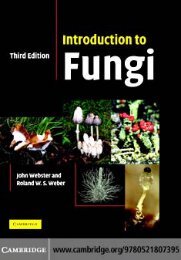Freshwater Algae: Identification and Use as Bioindicators
Freshwater Algae: Identification and Use as Bioindicators
Freshwater Algae: Identification and Use as Bioindicators
Create successful ePaper yourself
Turn your PDF publications into a flip-book with our unique Google optimized e-Paper software.
3.2 LAKES 115Table 3.5 Organic Pollution: Most Tolerant Algal Genera <strong>and</strong> Species (Palmer, 1969)No. Taxon Cl<strong>as</strong>sPollutionIndex<strong>Freshwater</strong> HabitatGenus1 Euglena Eu 5 Planktonic2 Oscillatoria Cy 5 Planktonic or benthic3 Chlamydomon<strong>as</strong> Ch 4 Planktonic4 Scenedesmus Ch 4 Planktonic5 Chlorella Ch 3 Planktonic6 Nitzschia Ba 3 Benthic or planktonic7 Navicula Ba 3 Benthic8 Stigeoclonium Ch 2 Attached9 Synedra Ba 2 Planktonic <strong>and</strong> epiphyticspecies10 Ankistrodesmus Ch 2 PlanktonicSpecies1 Euglena viridis Eu 6 Ponds <strong>and</strong> shallow lakes2 Nitzschia palea Ba 5 Lakes <strong>and</strong> rivers3 Oscillatoria limosa Cy 4 Stagnant or st<strong>and</strong>ing waters4 Scenedesmus quadricauda Ch 4 Lake phytoplankton5 Oscillatoria tenuis Cy 4 Ponds <strong>and</strong> shallow pools6 Stigeoclonium tenue Ch 3 Epiphyte, shallow waters7 Synedra ulna Ba 3 Lake phytoplankton8 Ankistrodesmus falcatus Ch 3 Lake phytoplankton9 P<strong>and</strong>orina morum Ch 3 Lake phytoplankton10 Oscillatoria chlorina Cy 2 Stagnant or st<strong>and</strong>ing watersTen most tolerant algal genera <strong>and</strong> species. listed (Palmer, 1969) in order of decre<strong>as</strong>ing tolerance. Algalphyla: Cyanophyta (Cy), Chlorophyta (Ch), Euglenophyta (Eu) <strong>and</strong> Bacillariophyta (Ba).Pollution index – see text.pollution w<strong>as</strong> originally pioneered by Kolkwitz <strong>and</strong>Marsson (1908).Palmer (1969) carried out an extensive literaturesurvey to <strong>as</strong>sess the tolerance of algal species to organicpollution, <strong>and</strong> to incorporate the data into anorganic pollution index for rating water quality. Algalgenera <strong>and</strong> species were listed separately in orderof their pollution tolerance (Table 3.5), <strong>and</strong> includeda wide range of taxa (euglenoids, blue-greens, greenalgae <strong>and</strong> diatoms) <strong>as</strong> well <strong>as</strong> planktonic <strong>and</strong> benthicforms. The <strong>as</strong>sessment of genera w<strong>as</strong> determined <strong>as</strong>the average of all recorded species within the genus,<strong>and</strong> is perhaps less useful than the species rating –where single, readily identifiable taxa can be directlyrelated to pollution level.The species organic pollution index developed byPalmer uses the top 20 algae in the species list (top10 shown in Table 3.5). Algal species are rated on <strong>as</strong>cale 1 to 5 (intolerant to tolerant) <strong>and</strong> the index issimply calculated by summing up the scores of allrelevant taxa present within the sample. In analysingthe water sample, all of the 20 species are recorded,<strong>and</strong> an alga is considered to be ‘present’ if there are50 or more individuals per litre.Examples of environmental scores are given in Table3.6, with values of >20 consistent with high organicpollution <strong>and</strong>
















